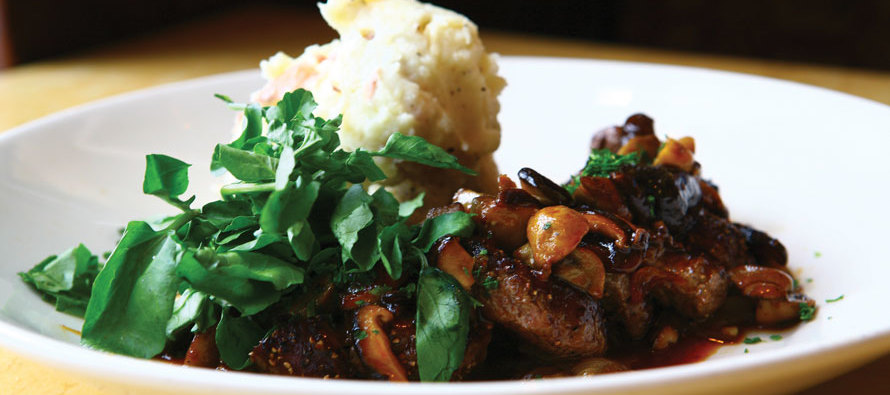Steak Diane Recipe

Accumulated from Mastering the Art of French Cooking by Julia Child, Louisette Bertholle, and Simone Beck as well as re-catching some of Julia’s shows on youtube.com that bore out some of the specific details. I love 2010.
This recipe exemplifies a flavor building trifecta known as the Sear-Deglaze-Reduce. The meat is allowed to adhere to a ridiculously hot pan until the brown on the pan and the brown on the meat are about the same-and the meat has “released” from the pan. Then it is flipped to a new, unmarred spot in the pan that is also ridiculously hot. Once you pull the meat out, aromatics are added and once soft, the deglazing occurs. An alcoholic liquid-at least an acidic liquid if not alcoholic-is added. This serves to “lift” the fond, or the crusty brown bits, from the pan. A bit of other flavorful liquid goes in, and the heat calms down so as to allow those flavors a chance to slowly mingle and get comfortable with one another.
During the reduction process – procedure #8 below – it is very important that the sauce does not boil rapidly. The reduction process is about allowing water and other volatile liquids to evaporate. If the mixture is boiling rapidly, it will take with it other compounds that are meant to be left in the sauce.
There is some debate as to whether or not the meat should be removed from the pan before deglazing. In this specific case, I am a believer in removing. When the protein item is left in place in the pan as deglazing occurs, the fond that is released from under the meat then sticks to the meat directly above it. That action creates a deeper, fuller crust on the meat itself which is obviously desirable for some protein items, namely scallops.
Drawbacks of leaving the meat in the pan during deglazing:
- The deglazing liquid catches fire, usually on purpose, but the fat from the pan that is igniting with the alcohol can impart some undesirable scorched flavors to the meat.
- The liquid is boiling and vaporizing rather rapidly which can steam the meat—awkwardly altering the texture and softening the crust.
- When the meat is removed to build the sauce, the delicious fond is adhered to the meat, great for the meat, bad for the sauce.
- Including aromatic vegetables in the development of the sauce becomes more difficult.
- Degreasing the pan before deglazing is more difficult
Ingredients Yield: 2 servings
1 ounce vegetable oil
4 ounces whole unsalted butter, cold and cut into small pieces
4 each 4 ounce medallions of beef tenderloin, uniformly ¾” thick, seasoned liberally and rested at room temperature for 15-20 minutes before cooking
1 small shallot, finely minced
¼ clove garlic, pasted
1 ounce Brandy, or Cognac
2 ounces Madeira
8 ounces veal stock, clarified and reduced by half
1 teaspoon Dijon mustard
10 leaves fresh thyme
¼ tablespoon Worcestershire sauce
½ each lemon, to be juiced a la minute
to taste sea salt
to taste black peppercorns, freshly ground
1 tablespoon parsley, finely chopped
Procedure
- In a stainless steel sauté pan just large enough to hold twice as many steaks as you are cooking, over high heat, add the vegetable oil and heat until shimmering.
- Into the shimmering oil, add 2 ounces of the butter and heat until the foam subsides.
- Into the hot butter, place the seasoned and tempered beef and press gently into the pan, sear over high heat, occasionally pressing gently to insure even contact, until the steak will lift up from the pan without sticking—about 2 minutes.
- Turn the steaks to the space in the pan that has not yet been “soiled” and repeat step two, removing the steaks to a resting rack in a warm place until they are needed.
- Reduce heat under the pan to medium and add the shallots, then garlic, season with salt and pepper, sweat until softened—about 90 seconds.
- Remove the pan from the heat, pour the brandy into the pan and return to the heat, tilting the pan so as to catch the alcohol on fire.
- Swirl the pan rapidly while vigorously loosing any remaining brown bits from the bottom of the pan by using a wooden spoon.
- Into the deglazed pan, add the Madeira, veal stock, mustard, thyme, and Worcestershire, reduce heat and allow to simmer and reduce by half – about 8 minutes.
- Taste and adjust seasoning as necessary—using the lemon juice to balance the fat or richness present if needed. Strain the sauce through a fine chinois and return to the original pan, reduce heat to low.
- Into the just-barely-simmering sauce, return the seared pieces of meat and their juices. Allow them to warm just on one side so as to maintain the crust on the other.
- Remove the beef from the sauce to the service plate.
- Remove the pan from the heat, mount the sauce with the remaining cold butter, stir in the finely chopped parsley and serve.

Brian O'Malley
Brian O'Malley is a chef instructor at Metropolitan Community College's Institute for the Culinary Arts. A graduate from New England Culinary Institute and a member of the American Culinary Federation, O'Malley worked as the chef/owner of Spread. He was a manager/instructor at the New England Culinary Institute, head chef at Vanilia in Santorini, Greece, and BackNine Grille, assistant food and beverage manager at the Champion's Club and opening chef at BOJO. Brian O'Malley can usually be found in MCC's kitchens, teaching, creating works of culinary genius or debating the perils of out of season tomatoes.
No comments
Write a commentOnly registered users can comment.











